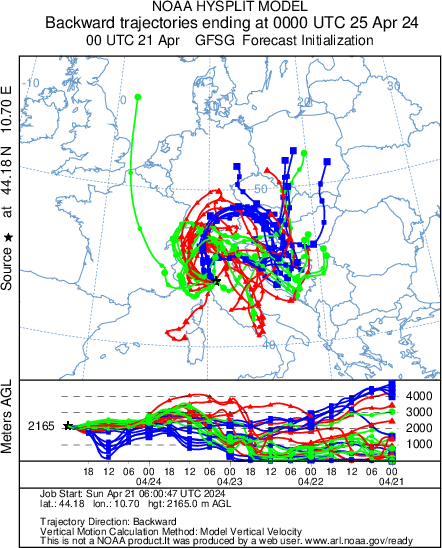Aerosol size distribution (300 nm – 20 µm)
Starting date: 1-8-2002
Status: Running
Instrumentation and calibration: Aerosol concentration and size distribution of particles with optical diameter between 0.30 and 20 μm have been continuously recorded in 15-size channel by using an OPC Mod. GRIMM 1.108. These measurements permit the determination of a fraction of fine mode (0.3 μm ≤ Dp ≤ 1 μm) and coarse mode (1 μm ≤ Dp≤ 20 μm) particles with a 1-minute time resolution. The instrument is based on the quantification of the 90° scattering of light by aerosol particles. According to the specifications, the reproducibility of the OPC in particle counting is ±2% (Putaud et al., 2004a).
Project affiliation (s) Present: SHARE, EUSAAR, GAW-WMO, CEOP-HE Past: MINATROC, OZOMONT
Related research programmes
- Tropospheric background condition
- Aerosol pproperties
- Long-range transport
- Saharan dust transport
- Polluted air-masses
Why is this research important? Because of its wide implication on meteorology, air quality and climatic changes, atmospheric aerosol represents one key aspect of current atmospheric research. Particulate matter is very effective in modifying the radiation field by absorbing and scattering solar and thermal radiation, thus impacting radiative transfer through the atmosphere. In particular, particles with diameter between 0.1 and 1 μm (the so-called accumulation mode) are highly effective to scatter incoming solar radiation. Additionally, aerosols act as cloud condensation and ice nuclei, thus influencing cloud properties. Aerosols also help to control the concentrations, lifetime and the physical as well as the chemical behaviour of many important trace gases by providing reaction sites and serving as carrier and/or sink for many atmospheric species. For instance, at Mt. Cimone, the mineral dust influence on tropospheric O3 concentrations has been extensively analysed (see Bibliography).
Quick look The seasonal aerosol number size distribution, characterized by a bimodal shape, showed a behaviour typical for background conditions, characterized by highest values in summer and lowest in winter. As deduced by Marinoni et al. (see references below), the seasonal and diurnal variations of the fine mode (0.3 ≤ Dp ≤ 1 μm average values: 26.15 cm−3) and the coarse mode (1 ≤ Dp ≤ 20 μm, average value: 0.17 cm−3) particle number concentrations exhibited a seasonal cycle with the highest values in spring–summer and the lowest value in autumn–winter. Except for winter, the fine particle showed a clear diurnal variation with high values during day-time. Coarse particle concentrations showed a less marked diurnal variation (but with higher variability), due to the influence of non-continuous sources of coarse particle (i.e. Saharan dust events).

Time-series of fine and coarse daily average values for year 2009 at ICO-OV. Large increase of coarse particle concentrations denotes Saharan dust transport
Near-real-time dust event identification An experimental service for the near-real time (NRT) dust alert is active for ICO-OV. The service, currently under advanced test phase, provides a near-real time detection of Saharan Dust Events (SDE) from North Africa as deduced by ICO-OV observations at Monte Cimone. SDE is detected when the in-situ aerosol number coarse (i.e. Dp > 1um) concentration exceeds 0.5 cm-3 for three consecutive hours and air-masses from Northern Africa are forecast by the HYSPLIT model, provided by NOAA-ARL. To take part in the test phase and to sign up for the service, write an e-mail to CIMONE-Dust-Alert [at] isac.cnr.it providing in the mail body the following information: Name, Surname, Institution, purpose of subscription. Your feedback is very welcome!!! Where can I find the data? EBAS - World Data Centre for Aerosol (WDCA) or by direct request to: p.cristofanelli [at] isac.cnr.it, a.marinoni [at] isac.cnr.it
Organization (s): ISAC-CNR Via Gobetti 101, I-40129, Bologna www.isac.cnr.it
Contact persons: Dr. Angela Marinoni e-mail: a.marinoni [at] isac.cnr.it, phone: +39 051 6399597 Dr. Paolo Cristofanelli e-mail: p.cristofanelli [at] isac.cnr.it phone: +39 051 6399597



